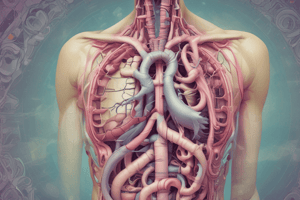Podcast
Questions and Answers
Which condition is characterized by the congenital malformation leading to exposure of abdominal contents?
Which condition is characterized by the congenital malformation leading to exposure of abdominal contents?
- Gastroschisis (correct)
- Esophageal carcinoma
- Pyloric stenosis
- Omphalocele
What are the common major risk factors associated with squamous cell carcinoma of the esophagus?
What are the common major risk factors associated with squamous cell carcinoma of the esophagus?
- Viral infections and genetics
- Obesity and sedentary lifestyle
- Exposure to sunlight
- Alcohol and tobacco (correct)
Which of the following symptoms is NOT typically associated with esophageal carcinoma?
Which of the following symptoms is NOT typically associated with esophageal carcinoma?
- Projectile vomiting (correct)
- Progressive dysphagia
- Hematemeisis
- Weight loss
In which location of the esophagus would lymph node spread primarily occur to the cervical nodes?
In which location of the esophagus would lymph node spread primarily occur to the cervical nodes?
What is the classical presentation of pyloric stenosis occurring two weeks after birth?
What is the classical presentation of pyloric stenosis occurring two weeks after birth?
What is the most common presentation of tracheoesophageal fistula?
What is the most common presentation of tracheoesophageal fistula?
Which condition is associated with increased risk of esophageal squamous cell carcinoma?
Which condition is associated with increased risk of esophageal squamous cell carcinoma?
What is a key symptom of Zenker diverticulum?
What is a key symptom of Zenker diverticulum?
What typically causes Mallory-Weiss syndrome?
What typically causes Mallory-Weiss syndrome?
What occurs as a result of portal hypertension in esophageal varices?
What occurs as a result of portal hypertension in esophageal varices?
Which of the following is a symptom of tracheoesophageal fistula?
Which of the following is a symptom of tracheoesophageal fistula?
Which of the following characteristics is associated with Plummer-Vinson syndrome?
Which of the following characteristics is associated with Plummer-Vinson syndrome?
What is the primary risk associated with esophageal varices?
What is the primary risk associated with esophageal varices?
What is the most common cause of unilateral sialadenitis?
What is the most common cause of unilateral sialadenitis?
Which of the following complications is least likely to occur with a mumps virus infection?
Which of the following complications is least likely to occur with a mumps virus infection?
What is a distinguishing feature of a pleomorphic adenoma?
What is a distinguishing feature of a pleomorphic adenoma?
Which of the following statements about Warthin tumor is incorrect?
Which of the following statements about Warthin tumor is incorrect?
Which type of salivary gland tumor is characterized as the most common malignant tumor?
Which type of salivary gland tumor is characterized as the most common malignant tumor?
What is the primary clinical feature associated with duodenal atresia?
What is the primary clinical feature associated with duodenal atresia?
Which statement regarding Meckel diverticulum is correct?
Which statement regarding Meckel diverticulum is correct?
In adults, intussusception is most commonly caused by what?
In adults, intussusception is most commonly caused by what?
Which of the following describes volvulus?
Which of the following describes volvulus?
The 'double bubble' sign is characteristic of which condition?
The 'double bubble' sign is characteristic of which condition?
Which age group is primarily affected by intussusception due to lymphoid hyperplasia?
Which age group is primarily affected by intussusception due to lymphoid hyperplasia?
What is the likely consequence of small bowel infarction?
What is the likely consequence of small bowel infarction?
Which of the following statements about Meckel diverticulum is incorrect?
Which of the following statements about Meckel diverticulum is incorrect?
What is the primary location of damage in Tropical Sprue?
What is the primary location of damage in Tropical Sprue?
Which process contributes to malabsorption in Whipple Disease?
Which process contributes to malabsorption in Whipple Disease?
What characterizes the deficiency seen in Abetalipoproteinemia?
What characterizes the deficiency seen in Abetalipoproteinemia?
What substance is secreted by carcinoid tumors that can lead to systemic effects?
What substance is secreted by carcinoid tumors that can lead to systemic effects?
What is a common site of metastasis for carcinoid tumors?
What is a common site of metastasis for carcinoid tumors?
How does Whipple Disease primarily affect fat absorption?
How does Whipple Disease primarily affect fat absorption?
What deficiency can result from damage in Tropical Sprue?
What deficiency can result from damage in Tropical Sprue?
What histological characteristic is associated with Whipple Disease?
What histological characteristic is associated with Whipple Disease?
What is a primary cause of acidic damage to the stomach mucosa in acute gastritis?
What is a primary cause of acidic damage to the stomach mucosa in acute gastritis?
Which risk factor is associated with Curling ulcers in patients?
Which risk factor is associated with Curling ulcers in patients?
What clinical feature is indicative of chronic autoimmune gastritis?
What clinical feature is indicative of chronic autoimmune gastritis?
What is the mechanism by which H. pylori contributes to chronic gastritis?
What is the mechanism by which H. pylori contributes to chronic gastritis?
Which type of gastritis is primarily associated with a lack of hydrochloric acid production?
Which type of gastritis is primarily associated with a lack of hydrochloric acid production?
What is a typical treatment for H. pylori-induced chronic gastritis?
What is a typical treatment for H. pylori-induced chronic gastritis?
Which statement about chronic gastritis caused by H. pylori is true?
Which statement about chronic gastritis caused by H. pylori is true?
In chronic autoimmune gastritis, what might lead to megaloblastic anemia?
In chronic autoimmune gastritis, what might lead to megaloblastic anemia?
What is one potential outcome of untreated chronic H. pylori gastritis?
What is one potential outcome of untreated chronic H. pylori gastritis?
What is a contributing factor to increased intracranial pressure leading to Cushing ulcers?
What is a contributing factor to increased intracranial pressure leading to Cushing ulcers?
What causes achalasia?
What causes achalasia?
What is the clinical feature that is notably associated with achalasia?
What is the clinical feature that is notably associated with achalasia?
Which imaging study is indicative of achalasia?
Which imaging study is indicative of achalasia?
Which of the following is a known risk factor for gastroesophageal reflux disease (GERD)?
Which of the following is a known risk factor for gastroesophageal reflux disease (GERD)?
What mechanism underlies Barrett esophagus?
What mechanism underlies Barrett esophagus?
Which type of esophageal cancer is most commonly associated with Barrett esophagus?
Which type of esophageal cancer is most commonly associated with Barrett esophagus?
What is a potential late complication of GERD?
What is a potential late complication of GERD?
What symptom might mimic cardiac chest pain in patients with GERD?
What symptom might mimic cardiac chest pain in patients with GERD?
What is the primary cause of solitary mucosal ulcers in the proximal duodenum?
What is the primary cause of solitary mucosal ulcers in the proximal duodenum?
In which location do gastric ulcers most commonly form?
In which location do gastric ulcers most commonly form?
What potential complication is associated with a rupture of a posterior duodenal ulcer?
What potential complication is associated with a rupture of a posterior duodenal ulcer?
Which statement about the differential diagnosis of ulcers is true?
Which statement about the differential diagnosis of ulcers is true?
What symptom typically characterizes gastric ulcers as opposed to duodenal ulcers?
What symptom typically characterizes gastric ulcers as opposed to duodenal ulcers?
What is a common characteristic of both cleft lip and palate?
What is a common characteristic of both cleft lip and palate?
What triggers the recurrence of aphthous ulcers?
What triggers the recurrence of aphthous ulcers?
Which of the following is the primary characteristic of Behçet Syndrome?
Which of the following is the primary characteristic of Behçet Syndrome?
What is the primary cause of oral herpes lesions?
What is the primary cause of oral herpes lesions?
Which statement regarding squamous cell carcinoma is true?
Which statement regarding squamous cell carcinoma is true?
What does erythroplakia indicate in the context of oral pathology?
What does erythroplakia indicate in the context of oral pathology?
Which condition is characterized by white plaques that cannot be scraped away?
Which condition is characterized by white plaques that cannot be scraped away?
Which of the following factors is NOT associated with squamous cell carcinoma?
Which of the following factors is NOT associated with squamous cell carcinoma?
What is the primary function of the lactase enzyme in the gastrointestinal system?
What is the primary function of the lactase enzyme in the gastrointestinal system?
Which of the following clinical symptoms is characteristic of lactose intolerance?
Which of the following clinical symptoms is characteristic of lactose intolerance?
What severe complication can arise in patients with celiac disease if dietary restrictions are not followed?
What severe complication can arise in patients with celiac disease if dietary restrictions are not followed?
Which antibody is typically used for diagnosis in individuals with suspected IgA deficiency related to celiac disease?
Which antibody is typically used for diagnosis in individuals with suspected IgA deficiency related to celiac disease?
What role do helper T cells play in celiac disease?
What role do helper T cells play in celiac disease?
What changes are observed in a duodenal biopsy of a patient with celiac disease?
What changes are observed in a duodenal biopsy of a patient with celiac disease?
What is the pathogenic component of gluten associated with celiac disease?
What is the pathogenic component of gluten associated with celiac disease?
Which symptom is classically seen in children with celiac disease?
Which symptom is classically seen in children with celiac disease?
Flashcards
Duodenal Atresia
Duodenal Atresia
A congenital condition where the duodenum fails to develop properly, often associated with Down syndrome.
Meckel Diverticulum
Meckel Diverticulum
An outpouching of the small intestine wall, often harmless, and possibly bleeding.
Small Bowel Volvulus
Small Bowel Volvulus
Twisting of the small intestine, leading to blockage or blood vessel damage.
Intussusception
Intussusception
Signup and view all the flashcards
Small Bowel Infarction
Small Bowel Infarction
Signup and view all the flashcards
Duodenal Atresia Symptoms
Duodenal Atresia Symptoms
Signup and view all the flashcards
Intussusception Cause (Children)
Intussusception Cause (Children)
Signup and view all the flashcards
Intussusception Cause (Adults)
Intussusception Cause (Adults)
Signup and view all the flashcards
Tropical Sprue:
Tropical Sprue:
Signup and view all the flashcards
Whipple Disease:
Whipple Disease:
Signup and view all the flashcards
Abetalipoproteinemia:
Abetalipoproteinemia:
Signup and view all the flashcards
Carcinoid Tumor:
Carcinoid Tumor:
Signup and view all the flashcards
Small bowel villi damage:
Small bowel villi damage:
Signup and view all the flashcards
Macrophages in Whipple Disease:
Macrophages in Whipple Disease:
Signup and view all the flashcards
Chylomicron transport:
Chylomicron transport:
Signup and view all the flashcards
Portal circulation and metabolism
Portal circulation and metabolism
Signup and view all the flashcards
Tracheoesophageal Fistula
Tracheoesophageal Fistula
Signup and view all the flashcards
Esophageal Web
Esophageal Web
Signup and view all the flashcards
Mallory-Weiss Syndrome
Mallory-Weiss Syndrome
Signup and view all the flashcards
Esophageal Varices
Esophageal Varices
Signup and view all the flashcards
Dysphagia
Dysphagia
Signup and view all the flashcards
Hematemesis
Hematemesis
Signup and view all the flashcards
Portal Hypertension
Portal Hypertension
Signup and view all the flashcards
Acute Gastritis Cause
Acute Gastritis Cause
Signup and view all the flashcards
Chronic Autoimmune Gastritis Cause
Chronic Autoimmune Gastritis Cause
Signup and view all the flashcards
Chronic Gastritis Type
Chronic Gastritis Type
Signup and view all the flashcards
Chronic Autoimmune Gastritis Symptoms
Chronic Autoimmune Gastritis Symptoms
Signup and view all the flashcards
Chronic H. pylori Gastritis Cause
Chronic H. pylori Gastritis Cause
Signup and view all the flashcards
Risk Factors for Acute Gastritis
Risk Factors for Acute Gastritis
Signup and view all the flashcards
H. Pylori Pathophysiology
H. Pylori Pathophysiology
Signup and view all the flashcards
Mucosal Defenses Stomach
Mucosal Defenses Stomach
Signup and view all the flashcards
Acute Gastritis Pathophysiology
Acute Gastritis Pathophysiology
Signup and view all the flashcards
Chronic Autoimmune Gastritis Diagnosis
Chronic Autoimmune Gastritis Diagnosis
Signup and view all the flashcards
Salivary Glands
Salivary Glands
Signup and view all the flashcards
Mumps
Mumps
Signup and view all the flashcards
Sialadenitis
Sialadenitis
Signup and view all the flashcards
Pleomorphic Adenoma
Pleomorphic Adenoma
Signup and view all the flashcards
Warthin Tumor
Warthin Tumor
Signup and view all the flashcards
Esophageal carcinoma symptoms
Esophageal carcinoma symptoms
Signup and view all the flashcards
Squamous cell carcinoma (Esophagus)
Squamous cell carcinoma (Esophagus)
Signup and view all the flashcards
Gastroschisis cause
Gastroschisis cause
Signup and view all the flashcards
Pyloric stenosis symptoms
Pyloric stenosis symptoms
Signup and view all the flashcards
Omphalocele cause
Omphalocele cause
Signup and view all the flashcards
Achalasia
Achalasia
Signup and view all the flashcards
Esophageal Motility
Esophageal Motility
Signup and view all the flashcards
GERD (Gastroesophageal Reflux Disease)
GERD (Gastroesophageal Reflux Disease)
Signup and view all the flashcards
Barrett's Esophagus
Barrett's Esophagus
Signup and view all the flashcards
Esophageal Adenocarcinoma
Esophageal Adenocarcinoma
Signup and view all the flashcards
Lower Esophageal Sphincter (LES)
Lower Esophageal Sphincter (LES)
Signup and view all the flashcards
Squamous Cell Carcinoma
Squamous Cell Carcinoma
Signup and view all the flashcards
Lactase Enzyme
Lactase Enzyme
Signup and view all the flashcards
Lactose Intolerance
Lactose Intolerance
Signup and view all the flashcards
Celiac Disease
Celiac Disease
Signup and view all the flashcards
Gluten in Celiac
Gluten in Celiac
Signup and view all the flashcards
Gliadin
Gliadin
Signup and view all the flashcards
Celiac Symptoms
Celiac Symptoms
Signup and view all the flashcards
Celiac Antibodies
Celiac Antibodies
Signup and view all the flashcards
Celiac Diet
Celiac Diet
Signup and view all the flashcards
Peptic Ulcers are usually caused by?
Peptic Ulcers are usually caused by?
Signup and view all the flashcards
How does a duodenal ulcer present?
How does a duodenal ulcer present?
Signup and view all the flashcards
Where do gastric ulcers usually develop?
Where do gastric ulcers usually develop?
Signup and view all the flashcards
What's the risky complication with a posterior duodenal ulcer?
What's the risky complication with a posterior duodenal ulcer?
Signup and view all the flashcards
Why are duodenal ulcers rarely malignant?
Why are duodenal ulcers rarely malignant?
Signup and view all the flashcards
Cleft Lip and Palate
Cleft Lip and Palate
Signup and view all the flashcards
Aphthous Ulcer
Aphthous Ulcer
Signup and view all the flashcards
Behçet Syndrome
Behçet Syndrome
Signup and view all the flashcards
Oral Herpes
Oral Herpes
Signup and view all the flashcards
Oral Leukoplakia
Oral Leukoplakia
Signup and view all the flashcards
Oral Candidiasis (Thrush)
Oral Candidiasis (Thrush)
Signup and view all the flashcards
Hairy Leukoplakia
Hairy Leukoplakia
Signup and view all the flashcards
Study Notes
Tropical Sprue
- Damage to small bowel villi
- Due to unknown organism
- Similar to celiac disease, except
- Occurs in tropical regions (e.g., Caribbean)
- Responds to antibiotics
- Damage most prominent in jejunum and ileum (secondary vitamin B12 or folate deficiency may ensue)
- Duodenum less commonly involved
Whipple's Disease
- Systemic tissue damage
- Macrophages loaded with Tropheryma whipplei organisms
- Partially destroyed organisms in macrophages
- Classic site of involvement: small bowel lamina propria
- Macrophages compress lacteals
- Results in fat malabsorption and steatorrhea
- Other common sites: synovium of joints (arthritis), cardiac valves, lymph nodes, CNS
Abetalipoproteinemia
- Autosomal recessive deficiency of apolipoprotein B-48 and B-100
- Clinical features
- Malabsorption
- Absent plasma VLDL and LDL (require B-100)
Carcinoid Tumor
- Malignant proliferation of neuroendocrine cells; low-grade malignancy,
- Tumor cells contain secretory granules that are positive for chromogranin.
- Can arise anywhere along the gut; small bowel is the most common site
- Grows as a submucosal polyp-like nodule
- Often secretes serotonin
- Serotonin is released into the portal circulation and metabolized by the liver
- 5-HIAA is excreted in the urine
- Metastasis of carcinoid tumor to the liver allows serotonin to bypass liver metabolism
- Serotonin released into the hepatic vein and leaks into systemic circulation via hepatosystemic shunts, resulting in carcinoid syndrome and carcinoid heart disease
Studying That Suits You
Use AI to generate personalized quizzes and flashcards to suit your learning preferences.
Description
Test your knowledge on various gastrointestinal disorders, including congenital malformations and esophageal conditions. This quiz covers key symptoms, risk factors, and presentations of conditions such as pyloric stenosis and tracheoesophageal fistulae. Challenge yourself and validate your understanding of these crucial medical topics.




